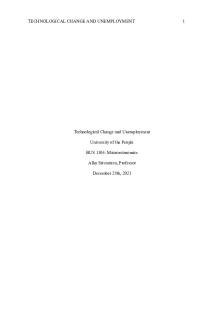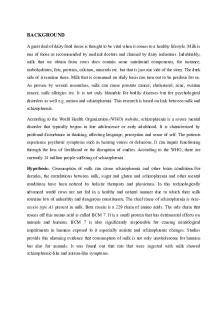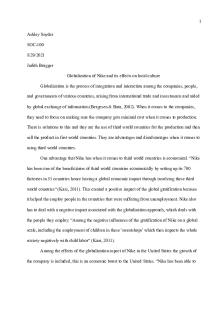Effects of Change Valence and Informational Assessments on Organi PDF

| Title | Effects of Change Valence and Informational Assessments on Organi |
|---|---|
| Author | dfgdf dsgfs |
| Course | Psychologie cognitive |
| Institution | Université Paris-Saclay |
| Pages | 174 |
| File Size | 2.6 MB |
| File Type | |
| Total Downloads | 52 |
| Total Views | 125 |
Summary
Download Effects of Change Valence and Informational Assessments on Organi PDF
Description
Walden University
ScholarWorks Walden Dissertations and Doctoral Studies
Walden Dissertations and Doctoral Studies Collection
2017
Effects of Change Valence and Informational Assessments on Organizational Readiness for Change James Edward Phillips Walden University
Follow this and additional works at: https://scholarworks.waldenu.edu/dissertations Part of the Business Administration, Management, and Operations Commons, Management Sciences and Quantitative Methods Commons, and the Organizational Behavior and Theory Commons This Dissertation is brought to you for free and open access by the Walden Dissertations and Doctoral Studies Collection at ScholarWorks. It has been accepted for inclusion in Walden Dissertations and Doctoral Studies by an authorized administrator of ScholarWorks. For more information, please contact [email protected].
Walden University College of Management and Technology
This is to certify that the doctoral dissertation by
James Edward Phillips
has been found to be complete and satisfactory in all respects, and that any and all revisions required by the review committee have been made.
Review Committee Dr. Anthony Lolas, Committee Chairperson, Management Faculty Dr. Thomas Spencer, Committee Member, Management Faculty Dr. Mohammad Sharifzadeh, University Reviewer, Management Faculty
Chief Academic Officer Eric Riedel, Ph.D.
Walden University 2017
Abstract Effects of Change Valence and Informational Assessment on Organizational Readiness for Change by James Edward Phillips
MS, Swinburne University, 2004 BA, University of South Carolina, 1988
Dissertation Submitted in Partial Fulfillment of the Requirements for the Degree of Doctor of Philosophy Management
Walden University July 2017
Abstract Nearly two-thirds of organizational change initiatives are unsuccessful due to a lack of high levels of change readiness prior to implementation of the change. A review of the literature supported the importance of establishing organizational readiness for change (ORC), but a gap remained in the empirical data and extant literature about whether presumed antecedents identified in ORC theory contribute to increased levels of ORC. The purpose of this study was to gather empirical data to address this question of whether change valence and informational assessment scores are associated with increased levels of organizational readiness for implementing change. The research design was quantitative and nonexperimental. Data were collected via online Likert-type survey from employees (n = 70) in an organization undergoing significant change. An analysis was performed using OLS regression and principal components analysis. The results showed that change valence and informational assessment were positively and significantly associated with increased organizational readiness for change score (β = 1.778, p < .001, and β = 1.392, p < .001, respectively), and that change commitment and efficacy loaded favorably in a principal components analysis of ORC score. The findings are significant to the field of management as they show how establishing increased levels of change valence and informational assessment may help positively influence employee participation and organizational change outcomes. The study is socially significant because it may illuminate differences in perception between employees and leadership regarding change and may contribute to greater inclusion of a broader array of employee perspectives, opinions, and experiences in the organizational change process.
Effects of Change Valence and Informational Assessment on Organizational Readiness for Change by James Edward Phillips
MS, Swinburne University, 2004 BA, University of South Carolina, 1988
Dissertation Submitted in Partial Fulfillment of the Requirements for the Degree of Doctor of Philosophy Management
Walden University July 2017
Dedication This dissertation and my doctoral degree are dedicated to the most important people in my life. To my wife, Celeste, thank you for all your sacrifice, support, and understanding. I could not have finished this without you. I love you so. To my daughter, Arabella, and my son, Samuel, work hard, chase your dreams, and always remember that you can do anything. To my Mother, I wish you had lived long enough to share in this. I miss you.
Acknowledgments I would like to acknowledge those who have helped me along the journey to completing my doctoral dissertation. A very special thank you to my academic mentor and Dissertation Committee Chairman, Dr. Anthony Lolas. I could not have achieved this without his insightful guidance, tireless support, and unwavering encouragement over the past three years. I could not have asked for a better Chair. My sincerest thanks and appreciation to my Dissertation Committee Member, Dr. Thomas Spencer, for his invaluable advice and guidance, and for helping me make sure that my statistical analyses made sense. To Dr. Mohammad Sharifzadeh, my Dissertation URR, thank you. Your advice made me a better researcher and your guidance made my dissertation better. Special thanks to everyone in Walden’s various support offices for all the help they rendered along the way. Finally, I am forever grateful to Walden University’s leadership for their support of the CCSSO National Teacher of the Year Program. Without their generosity this highest of academic achievements would not have been possible.
Table of Contents List of Tables ..................................................................................................................... iv List of Figures .................................................................................................................... vi Chapter 1: Introduction to the Study....................................................................................1 Background ....................................................................................................................2 Problem Statement .........................................................................................................6 Purpose of the Study ......................................................................................................7 Research Questions and Hypotheses .............................................................................7 Theoretical Framework for the Study ............................................................................9 Nature of the Study ......................................................................................................11 Study Sample ........................................................................................................ 12 Data Collection ..................................................................................................... 13 Data Analysis ........................................................................................................ 14 Definitions....................................................................................................................14 Assumptions .................................................................................................................15 Scope and Delimitations ..............................................................................................17 Limitations ...................................................................................................................17 Significance..................................................................................................................20 Summary ......................................................................................................................21 Chapter 2: Literature Review .............................................................................................23 Overview of Theories ..................................................................................................26 Review of Empirical Studies .......................................................................................35
i
Precursors of Organizational Readiness for Change ............................................ 39 Sequels of Organizational Readiness for Change ................................................. 52 Gaps in the Literature...................................................................................................53 Conclusion ...................................................................................................................59 Chapter 3: Methodology ....................................................................................................64 Overview and Selection of Methodologies ..................................................................65 Overview and Selection of Research Designs .............................................................68 Instrumentation and Measurement...............................................................................70 Population, Sample, and Setting ..................................................................................75 Ethical Procedures .......................................................................................................77 Data Collection ............................................................................................................78 Data Analysis ...............................................................................................................79 Data Analysis, RQ1 .............................................................................................. 79 Data Analysis, RQ2 .............................................................................................. 82 Data Analysis, RQ3 .............................................................................................. 84 Data Analysis, RQ4 .............................................................................................. 85 Reliability and Validity ................................................................................................86 Conclusion ...................................................................................................................86 Chapter 4: Results ..............................................................................................................90 Introduction ..................................................................................................................90 IRB Approval ...............................................................................................................91 Data Collection ............................................................................................................92
ii
Demographic Statistics ................................................................................................93 Covariate Data Coding.................................................................................................94 Analyses and Results ...................................................................................................97 RQ1 Results .......................................................................................................... 97 RQ2 Results ........................................................................................................ 103 RQ3 Results ........................................................................................................ 109 RQ4 Results ........................................................................................................ 114 Summary ....................................................................................................................122 Chapter 5: Conclusion......................................................................................................124 Introduction ................................................................................................................124 Interpretation of the Findings.....................................................................................124 Limitations of the Study.............................................................................................131 Reliability and Validity ..............................................................................................133 Recommendations ......................................................................................................133 Practice Recommendations ................................................................................. 134 Scholarly Recommendations .............................................................................. 135 Implications for Practice ............................................................................................138 Significance to Social Change ...................................................................................139 Conclusion .................................................................................................................139 References ........................................................................................................................143
iii
List of Tables Table 1. Organizational Readiness for Implementing Change Items ............................... 33 Table 2. Difference Between Quantitative and Qualitative Research .............................. 66 Table 3. Model for RQ1 .................................................................................................... 82 Table 4. Model for RQ2 .................................................................................................... 83 Table 5. Model for RQ3 .................................................................................................... 85 Table 6. Frequency Distribution by Age of all Respondents ............................................ 95 Table 7. Frequency Distribution by Gender of all Respondents ....................................... 95 Table 8. Frequency Distribution by Tenure of all Respondents ....................................... 96 Table 9. Frequency Distribution by Organization Position of all Respondents ............... 96 Table 10. Frequency Distribution by Change Experience for all Respondents ................ 97 Table 11. Summary of RQ1 OLS Regression Model ....................................................... 98 Table 12. Coefficients for RQ1 OLS Regression Model .................................................. 99 Table 13. Summary of RQ1 Backward Elimination Regression Model ......................... 101 Table 14. Coefficients for RQ1 Backward Elimination Regression Model ................... 102 Table 15. Summary of RQ2 OLS Regression Model ..................................................... 104 Table 16. Coefficients for RQ2 OLS Regression Model ................................................ 104 Table 17. Summary of RQ2 Backward Elimination Regression Model ......................... 107
iv
Table 18. Coefficients for RQ2 Backward Elimination Regression Model ................... 108 Table 19. Summary of RQ3 OLS Regression Model ..................................................... 110 Table 20. Coefficients for RQ3 OLS Regression Model ................................................ 110 Table 21. Summary of RQ3 Backward Elimination Regression Model ......................... 112 Table 22. Coefficients for RQ3 Backward Elimination Regression Model ................... 113 Table 23. KMO Measure of Sampling Adequacy & Bartlett’s Test of Spericity ........... 116 Table 24. KMO Anti-image Correlation Matrix for all Extracted Items ........................ 117 Table 25. Total Variance of Extracted Components ....................................................... 118 Table 26. Model Summary for Principal Components Analysis for Categorical Data .. 120 Table 27. Rotated Components Matrix of the Principal Components Analysis ............. 121 Table 28. Hypothesis Testing Outcomes ........................................................................ 122
v
List of Figures Figure 1. Determinants and outcomes of ORC ................................................................. 10 Figure 2. Determinants and outcomes of ORC ................................................................. 70 Figure 3. A priori sample size analysis ............................................................................. 77 Figure 4. Post hoc sample size analysis ............................................................................ 93 Figure 5. Scatterplot of ORC as a function of change valence ......................................... 99 Figure 6. Residuals-versus-fitted values plot of the RQ1 unexpanded model................ 100 Figure 7. Residuals-versus-fitted values plot of the RQ1 expanded model.................... 103 Figure 8. Scatterplot of ORC as a function of informational assessment ....................... 105 Figure 9. Residuals-versus-fitted values plot of the RQ2 unexpanded model................ 106 Figure 10. Residuals-versus-fitted values plot of the RQ3 unexpanded model.............. 111 Figure 11. Scree plot of Eigenvalues for all PCA items ................................................. 119
vi
1 Chapter 1: Introduction to the Study Nearly two-thirds of organizational change implementations are unsuccessful and do not achieve the intended change outcomes (Choi, 2011). This is often due to a lack of understanding on the part of leadership of the importance that organizational commitment to change plays in achieving successful change outcomes (Choi, 2011). In addition, as much as one-half of attempts at implementing change initiatives are not successful because sufficient readiness for change does not exist at the organizational level (Shea, Jacobs, Esserman, Bruce, & Weiner, 2014a; Weiner, 2009). This study focused research on the construct of readiness for change by field-testing the premise of Weiner’s (2009) theory of organizational change readiness and the recently developed psychometric measure by Shea, Jacobs, Esserman, Bruce, & Weiner (2014b) that is based on that theory. The study is significant to the field of management as it addresses how establishing increased levels of readiness for change may help leadership positively influence change outcomes. The study is socially significant because it could create a greater understanding of the differences in perception that exist between employees and leadership regarding change, and may contribute to greater inclusion of employee perspectives, opinions, and experiences in the organizational change process. This study consists of five chapters. Chapter 1 contains an introduction to the study. Chapter 2 contains a critical review of the literature related to organizational readiness for change and discusses supporting and conflicting theories. The literature review identified widely recognized theories of change commitment and change efficacy,
2 at both the individual and organizational levels, as key determinants in the production of successful outcomes in change initiatives. It also identified several gaps that exist within the literature related to organizational readiness for change, as well as an opportunity for empirically testing Weiner’s (2009) and Shea et al.’s (2014a) theory. Chapter 3 defines and describes the quantitative research methods and measurements used to test Weiner’s and Shea et al.’s organizational readiness for implementing change theory. It provides a description of the methodology to test the relationship between the various antecedents of readiness for change and how and in what degree they contribute to organizational readiness for change among leaders and employees of an organization in the United States during the implementation of a substantial change initiative. Chapter 4 presents an analysis and discussion of testing results. Lastly, Chapter 5 provides a discussion of the findings of the study, as well as the conclusions drawn, recommendati...
Similar Free PDFs

Organi CAVI ED Organi Pieni
- 3 Pages

Effects of internet on society
- 3 Pages

Effects Of Sitcoms On Teenagers
- 6 Pages

Aerobic and MSK Assessments
- 7 Pages

Social Media and Effects on Behavior
- 10 Pages
Popular Institutions
- Tinajero National High School - Annex
- Politeknik Caltex Riau
- Yokohama City University
- SGT University
- University of Al-Qadisiyah
- Divine Word College of Vigan
- Techniek College Rotterdam
- Universidade de Santiago
- Universiti Teknologi MARA Cawangan Johor Kampus Pasir Gudang
- Poltekkes Kemenkes Yogyakarta
- Baguio City National High School
- Colegio san marcos
- preparatoria uno
- Centro de Bachillerato Tecnológico Industrial y de Servicios No. 107
- Dalian Maritime University
- Quang Trung Secondary School
- Colegio Tecnológico en Informática
- Corporación Regional de Educación Superior
- Grupo CEDVA
- Dar Al Uloom University
- Centro de Estudios Preuniversitarios de la Universidad Nacional de Ingeniería
- 上智大学
- Aakash International School, Nuna Majara
- San Felipe Neri Catholic School
- Kang Chiao International School - New Taipei City
- Misamis Occidental National High School
- Institución Educativa Escuela Normal Juan Ladrilleros
- Kolehiyo ng Pantukan
- Batanes State College
- Instituto Continental
- Sekolah Menengah Kejuruan Kesehatan Kaltara (Tarakan)
- Colegio de La Inmaculada Concepcion - Cebu










